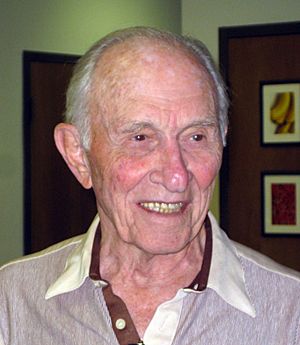Norman Farberow facts for kids
Quick facts for kids
Norman Farberow
|
|
|---|---|

Farberow at Didi Hirsch Mental Health Services' Survivors After ... event in Culver City, California, June 27, 2009
|
|
| Born |
Norman Louis Farberow
February 12, 1918 Pittsburgh, Pennsylvania, U.S.
|
| Died | September 10, 2015 (aged 97) Los Angeles, California, U.S.
|
| Nationality | American |
| Alma mater | University of California, Los Angeles |
| Known for | A founding father of modern suicidology |
| Scientific career | |
| Fields | Psychology Suicidology |
| Influences | Karl Menninger |
Norman Louis Farberow (born February 12, 1918 – died September 10, 2015) was an important American psychologist. He is known as one of the main people who helped start the modern study of how to prevent people from harming themselves. In 1958, he helped create the Los Angeles ... Prevention Center. This center became a key place for research on how to understand and prevent people from ending their lives.
Contents
Early Life and Education
Norman Farberow was born in 1918 in Pittsburgh, Pennsylvania. After serving in World War II, he went to the University of California, Los Angeles (UCLA).
He earned his doctoral degree from UCLA in 1950. At that time, there wasn't much information about helping people who were thinking about harming themselves. Farberow saw a chance to bring attention to this important but often ignored topic.
While studying, he also worked with veterans at the Veterans Administration Mental Hygiene Clinic. This experience helped him understand the emotional challenges many people faced.
World War II Service
During World War II, Farberow served as a Captain in the Air Force. His time in the military showed him the difficulties soldiers faced when they returned home. Many needed help adjusting to civilian life and dealing with emotional stress.
A Career Helping Others
Farberow saw how tough it was for people, especially veterans, to cope with emotional problems. He realized that these struggles often made their lives even harder. He dedicated his career to understanding and helping people in distress.
His work focused on finding ways to support those who were suffering. He wanted to prevent people from feeling so hopeless that they might consider harming themselves.
Understanding Risky Behaviors
Farberow studied different ways people might put themselves at risk. He called this "indirect self-destructive behavior." This included a wide range of actions, from mild things like smoking to more serious ones like ignoring medical advice.
He also looked at risky hobbies or behaviors that seemed to avoid sadness. Farberow believed that understanding these actions was key to helping people who might be struggling. He wrote a book about this called The Many Faces of ....
Support Groups for Grieving Families
Farberow also developed new ways to help families after a loved one had died. These families often felt alone and didn't get the usual support from friends or community.
He helped create a new kind of group therapy. These groups were different from traditional therapy. They focused on caring, sharing, and supporting each other. They were not about solving deep personal problems.
The Los Angeles ... Prevention Center started this new model in the 1980s.
- Meetings were led by a mental health expert and someone who had also experienced a similar loss.
- Meetings lasted eight weeks, with optional monthly follow-ups.
This program, called "Survivors After ...", quickly became popular in the United States and Canada. It helped many people find comfort and support during difficult times.
Working with Others Around the World
Farberow believed that helping people was a global effort. He worked with Dr. Erwin Ringel from Austria to create an international organization. This organization would bring together experts from different countries.
They had different ideas about how the group should be set up. Farberow wanted it to be like American psychology groups, while Ringel preferred a European style. But they worked through their differences. Their hard work led to the creation of the International Association for ... Prevention (IASP). This global group is a very important part of Farberow's lasting impact.
Farberow's Impact and Legacy
Norman Farberow was a very active researcher and writer. He published many books, articles, and manuals throughout his career. His work helped people understand why some individuals might be at risk.
He studied different groups of people, including young people, older adults, and those with long-term illnesses. His research also covered how to help people during big natural disasters.
Farberow's writings have been translated into many languages, including Japanese, Finnish, German, Swedish, French, Spanish, and Korean. His work continues to help people around the world.
Personal Life
Norman Farberow was married to Pearl (1925–2008), who was a teacher and counselor. They had a son and a daughter.
Images for kids


